High-Intensity Interval Training (HIIT) has gained immense popularity in recent years as an effective and efficient method for shedding unwanted pounds, particularly when it comes to targeting stubborn belly fat.
This intense workout strategy, characterized by alternating short bursts of vigorous exercise with brief periods of rest or low-intensity recovery, has become a go-to choice for fitness enthusiasts seeking rapid and sustainable results.
Belly fat, often referred to as visceral fat, can be particularly challenging to get rid of due to its location around vital organs, and its association with various health risks, including heart disease, diabetes, and more.
While spot reduction of fat is generally considered a myth, HIIT has shown remarkable promise in reducing overall body fat, including that notorious belly bulge.
The science behind HIIT’s effectiveness lies in its ability to elevate heart rate, maximize calorie burn, and create a powerful afterburn effect known as excess post-exercise oxygen consumption (EPOC). This means that even after you’ve completed your HIIT session, your body continues to burn calories at an accelerated rate, potentially for hours.
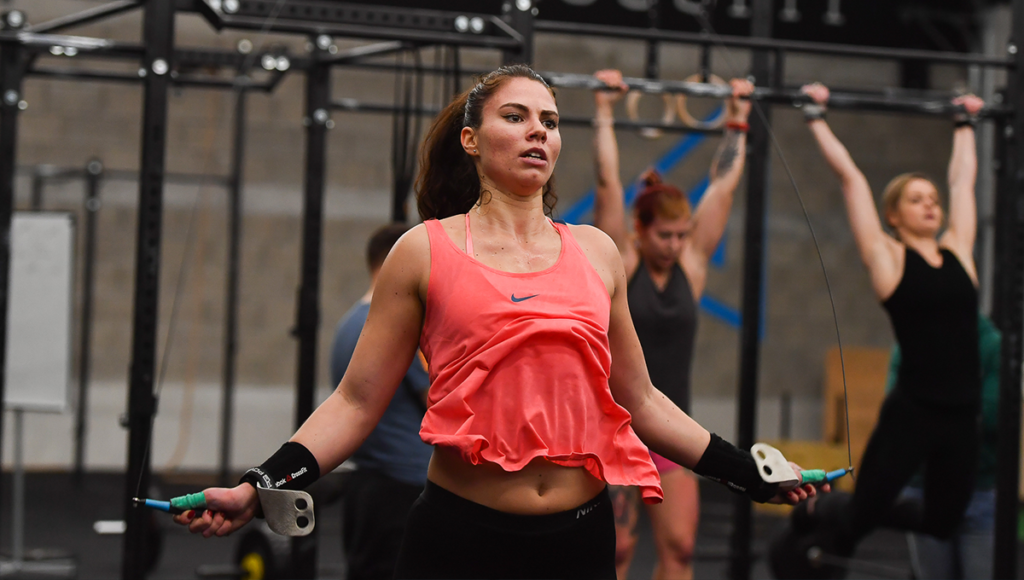 Source: Stevie D Photography
Source: Stevie D PhotographyIn this article, we’ll delve into the science behind HIIT and fat burning, explore the best HIIT exercises to target belly fat, and provide you with the knowledge and tools necessary to embark on your own journey towards a slimmer and healthier midsection.
Whether you’re a seasoned athlete or just starting out on your fitness quest, HIIT has the potential to transform your body and boost your confidence. So, let’s dive into the world of high-intensity interval training and discover how it can help you lose belly fat faster than ever before.
The Science Behind HIIT and Fat Burning
High-Intensity Interval Training (HIIT) has garnered a reputation as one of the most effective methods for burning fat, and understanding the science behind its effectiveness can help you grasp why it’s so efficient at torching stubborn belly fat.
Elevation of Heart Rate:
During a HIIT workout, the heart rate significantly increases. This intense cardiovascular response leads to a higher calorie burn than steady-state cardio exercises. When you engage in short, high-intensity bursts, your body demands more oxygen to support the increased workload, causing your heart to pump faster.
Maximizing Calorie Burn:
HIIT workouts are designed to push your body to its limits in a short amount of time. By doing so, you burn a substantial number of calories in a relatively brief period. This energy expenditure is crucial for weight loss, as it creates a calorie deficit, meaning you burn more calories than you consume.
Excess Post-Exercise Oxygen Consumption (EPOC):
One of the most compelling aspects of HIIT is its ability to trigger the afterburn effect, scientifically known as Excess Post-Exercise Oxygen Consumption (EPOC). After an intense HIIT session, your body continues to require extra oxygen to restore itself to its pre-exercise state. This post-workout oxygen debt means your metabolism remains elevated, and you continue to burn calories for several hours, and sometimes even up to 24 hours, after the workout. EPOC is a significant contributor to overall fat loss and can have a profound impact on reducing belly fat.
Hormonal Impact:
HIIT has been found to have a beneficial impact on various hormones involved in fat metabolism. It can increase the release of catecholamines, such as adrenaline and noradrenaline, which mobilize fat from fat cells to be used for energy. Additionally, HIIT can improve insulin sensitivity, potentially helping regulate blood sugar levels and reducing fat storage.

Muscle Preservation:
While HIIT predominantly burns fat, it also helps maintain lean muscle mass. This is crucial because muscle tissue requires more energy (calories) to maintain than fat tissue. Preserving or even increasing muscle mass through HIIT can boost your resting metabolic rate, further contributing to fat loss, including that stubborn belly fat.
In summary, the science behind HIIT and fat burning is rooted in its ability to elevate heart rate, maximize calorie burn, induce the EPOC effect, impact hormonal balance, and promote muscle preservation.
These factors make HIIT a potent tool for anyone looking to shed excess belly fat and improve their overall body composition. However, it’s important to note that no exercise regimen alone can outperform a poor diet. Proper nutrition and a balanced, calorie-controlled diet are essential for achieving your fat loss goals. In the next sections of this article, we’ll explore the best HIIT exercises specifically designed to target belly fat, while also emphasizing the importance of a healthy diet in your weight loss journey.
Preparing for Your HIIT Belly Fat Burning Journey
Embarking on a High-Intensity Interval Training (HIIT) journey to target and burn stubborn belly fat requires thoughtful preparation to ensure your safety and success. Here are essential steps to consider as you get ready to dive into this highly effective fat-burning workout regimen:
Consult with a Healthcare Professional
Before starting any new exercise program, especially one as intense as HIIT, it’s crucial to consult with a healthcare professional, particularly if you have any underlying health conditions or concerns. Your physician can help you determine whether HIIT is a suitable choice for your fitness level and overall health.
Set Clear Goals
Define your goals for undertaking a HIIT program. Whether you’re looking to lose a specific amount of weight, reduce your waistline, or simply improve your fitness level, having clear objectives will help keep you motivated and on track.
Select Suitable HIIT Workouts
Not all HIIT workouts are created equal, and choosing the right ones can make a significant difference in your belly fat loss journey. Research and select HIIT routines that specifically target the core and engage multiple muscle groups. This will help you maximize your fat-burning potential and sculpt your midsection.
Invest in Proper Footwear and Attire
High-intensity workouts place a lot of stress on your joints and muscles, so it’s crucial to invest in appropriate workout attire and footwear. Choose shoes with good arch support and cushioning to minimize the risk of injury. Comfortable, moisture-wicking clothing will also enhance your overall workout experience.
Warm-Up and Cool Down
Never skip your warm-up and cool-down routines. Warming up prepares your body for the intense exercise that follows, while cooling down helps your heart rate gradually return to normal and reduces the risk of post-workout dizziness or muscle soreness.
Hydration and Nutrition
Staying properly hydrated is essential during any workout, but it’s especially critical during HIIT. Dehydration can hinder your performance and recovery. Additionally, focus on balanced nutrition to support your energy levels and overall health. A diet rich in lean proteins, whole grains, and plenty of fruits and vegetables will help you get the most out of your workouts.
Incorporate Rest Days
While HIIT can be highly effective, it’s also demanding on your body. Ensure you incorporate rest days into your weekly routine to allow your muscles to recover and reduce the risk of overtraining, which can lead to burnout and injuries.
 Source: Motoki Tonn on Unsplash
Source: Motoki Tonn on UnsplashMonitor Progress
Tracking your progress is essential for staying motivated and making adjustments to your workout routine as needed. Consider keeping a workout journal or using fitness apps to record your sessions, improvements in performance, and changes in body measurements.
Safety First
Your safety should be your top priority. Pay close attention to your body’s signals during workouts. If you experience pain, dizziness, or any discomfort beyond the usual intensity of exercise, stop immediately and seek guidance from a fitness professional or healthcare provider.
By following these preparatory steps, you’ll be better equipped to embark on your HIIT belly fat burning journey with confidence and maximize your chances of achieving your fitness goals. Remember that consistency and dedication are key, so stay committed to your HIIT program and the results will come.
Burpees: The Ultimate Full-Body Fat Burner
When it comes to High-Intensity Interval Training (HIIT) exercises, few are as effective and demanding as the humble yet mighty burpee.
This full-body exercise is renowned for its ability to torch calories, elevate heart rate, and target stubborn belly fat. In this section, we’ll dive into the science and technique behind burpees and why they are considered one of the best exercises for overall fat loss.
The Science Behind Burpees and Fat Burning
Burpees are a dynamic combination of bodyweight exercises, incorporating squats, push-ups, and explosive jumps. This variety of movements engages multiple muscle groups simultaneously, leading to a significant increase in calorie burn. Here’s how burpees contribute to fat burning:
Elevated Heart Rate: Burpees involve rapid transitions between different phases of the exercise, including squats, plank positions, and jumps. This constant movement keeps your heart rate elevated, turning your body into a calorie-burning furnace.
Calorie Burn: The intensity of burpees leads to a high caloric expenditure in a short amount of time. By incorporating both strength and cardio elements, burpees effectively target fat loss, including that stubborn belly fat.
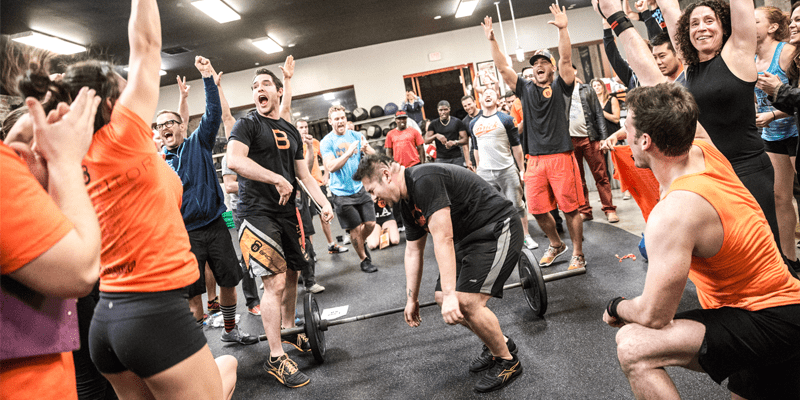 Source: Photo courtesy of CrossFit Inc taken at Brick Los Angeles
Source: Photo courtesy of CrossFit Inc taken at Brick Los AngelesFull-Body Engagement: Burpees engage major muscle groups like your legs, core, chest, and shoulders. This full-body activation not only burns calories during the exercise but also helps build lean muscle, which further enhances your metabolism and contributes to long-term fat loss.
EPOC Effect: Just like other HIIT exercises, burpees trigger the Excess Post-Exercise Oxygen Consumption (EPOC) effect. This means you’ll continue burning calories at an elevated rate even after you’ve completed your burpee session, potentially accelerating belly fat loss.
How to Perform Burpees
Performing burpees correctly is essential to maximize their fat-burning potential and minimize the risk of injury. Here’s a step-by-step guide:
- Begin in a standing position with your feet shoulder-width apart.
- Drop into a squat position with your hands on the floor in front of you.
- Kick your feet back, landing in a plank position.
- Perform a push-up (optional, depending on your fitness level).
- Jump your feet back to the squat position.
- Explode up from the squat into a jump, reaching your arms overhead.
- Land softly, returning to the squat position to start the next repetition.
Tips for Effective Burpees
- Start slowly and focus on proper form before increasing the speed or intensity.
- Modify the exercise if needed by skipping the push-up or reducing the jump height.
- Incorporate burpees into your HIIT routine with a set duration or a specific number of repetitions.
- Gradually increase the intensity and repetitions as your fitness level improves.
Burpees are a powerhouse exercise in the realm of HIIT, offering a multifaceted approach to fat burning.
By engaging multiple muscle groups, elevating heart rate, and inducing the EPOC effect, burpees stand as one of the most effective tools in your arsenal for shedding excess belly fat. Incorporate them into your HIIT routine, stay consistent, and watch your fitness and fat loss goals come within reach.
High Knees: A High-Intensity Cardio Workout
If you’re looking to elevate your heart rate, burn calories, and boost your cardiovascular fitness while targeting that persistent belly fat, high knees are a high-intensity cardio exercise you should definitely consider. This simple yet incredibly effective exercise has a range of benefits, making it an excellent addition to your High-Intensity Interval Training (HIIT) routine.
The Science Behind High Knees and Fat Burning
High knees are an excellent cardiovascular exercise that effectively burns calories and promotes fat loss. Here’s how high knees contribute to your fat-burning goals:
Elevated Heart Rate: The rapid movement of lifting your knees as high as possible while maintaining a quick pace significantly increases your heart rate. This sustained elevation in heart rate is a key factor in calorie burn and fat loss.
Calorie Burn: High knees require considerable energy and exertion, leading to a high caloric expenditure. When you create a calorie deficit by burning more calories than you consume, your body turns to stored fat for energy, including the fat in your abdominal area.
Core Engagement: High knees engage your core muscles, helping to strengthen and tone your midsection. While no exercise can spot-reduce fat, a strong core can contribute to a flatter and more defined belly when combined with fat loss.
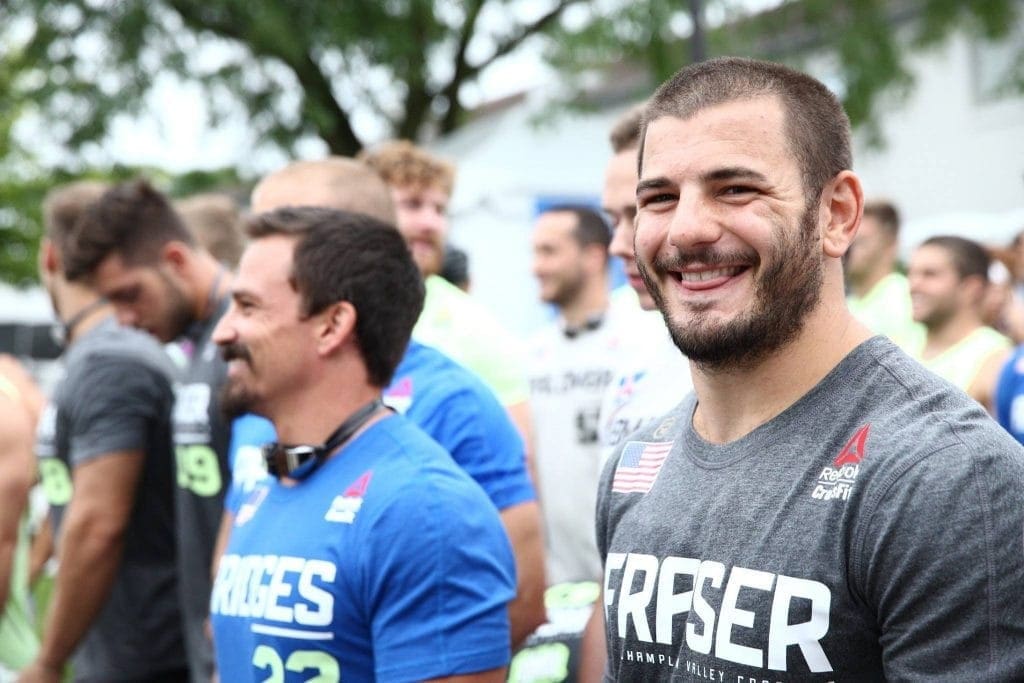 Source: Courtesy of CrossFit Inc.
Source: Courtesy of CrossFit Inc.Cardiovascular Fitness: High knees improve your cardiovascular endurance, enhancing your body’s ability to efficiently use oxygen and transport it to muscles. This can lead to better overall workout performance and increased fat-burning potential during your HIIT sessions.
How to Perform High Knees
- Begin by standing with your feet hip-width apart, shoulders relaxed, and arms hanging by your sides.
- Lift your right knee as high as possible while driving the opposite arm upward in a running motion.
- Lower your right leg back to the ground and immediately raise your left knee and right arm.
- Continue this running motion at a brisk pace, striving to bring your knees as close to your chest as possible.
Tips for Effective High Knees:
- Maintain a quick pace to maximize calorie burn and cardiovascular benefits.
- Engage your core muscles to help stabilize your body as you lift your knees.
- Focus on proper form, ensuring your movements are controlled and balanced.
- Start with a manageable duration, and gradually increase the time or intensity as your fitness level improves.
Incorporating High Knees into Your HIIT Routine
High knees are a versatile exercise that can be incorporated into your HIIT workouts in various ways. You can do them as a standalone exercise, intersperse them with other high-intensity exercises, or use them as an active rest period between more intense movements. Their adaptability makes them an ideal choice for any fitness level.
High knees are a fantastic addition to your HIIT routine for those seeking to boost cardiovascular fitness and burn calories effectively, including that stubborn belly fat. With dedication and consistency, high knees can help you achieve your fitness goals while strengthening your core and improving your overall endurance. So lace up those sneakers and get those knees pumping on your journey towards a fitter, leaner you.
Mountain Climbers: Core and Cardio Intensive
Mountain climbers are a dynamic and challenging exercise that combines core strength, cardiovascular fitness, and overall body coordination.
If you’re looking for an exercise that can help you torch calories and sculpt your core while engaging in High-Intensity Interval Training (HIIT), mountain climbers are a must-include in your workout routine.
The Science Behind Mountain Climbers and Fat Burning
Mountain climbers are a full-body exercise that targets both your core muscles and your cardiovascular system. Here’s how mountain climbers contribute to fat burning:
Core Engagement: This exercise requires you to maintain a strong plank position while quickly moving your knees toward your chest. This constant core engagement helps to strengthen and tone your abdominal muscles, making them an ideal choice for improving the appearance of your midsection.
Calorie Burn: Mountain climbers are a high-intensity exercise that demands a significant amount of energy. The fast-paced, full-body movement helps burn calories rapidly, creating a calorie deficit necessary for fat loss.
Cardiovascular Workout: The rapid leg movement and transition from one leg to the other elevate your heart rate. This aerobic component of mountain climbers not only enhances your cardiovascular fitness but also maximizes calorie burn during your workout.
Full-Body Engagement: While the primary focus is on your core and cardio, mountain climbers also engage your upper body, lower body, and hip flexors. The result is a well-rounded, fat-burning workout that targets multiple muscle groups simultaneously.
How to Perform Mountain Climbers
- Start in a push-up position with your hands shoulder-width apart and your body forming a straight line from head to heels.
- Engage your core and drive your right knee toward your chest, keeping your toes off the ground.
- Quickly return your right leg to the starting position and simultaneously bring your left knee toward your chest.
- Continue alternating between your right and left legs, mimicking the motion of running in place.
Tips for Effective Mountain Climbers
- Maintain proper form by keeping your hands beneath your shoulders and your body in a straight line.
- Focus on a rapid and controlled movement of your legs to maximize calorie burn and cardiovascular benefits.
- Engage your core throughout the exercise to ensure stability and protect your lower back.
Incorporating Mountain Climbers into Your HIIT Routine:
Mountain climbers can be incorporated into your HIIT workouts in various ways. You can perform them in intervals, combining them with other high-intensity exercises or use them as a finishing move to exhaust your core and elevate your heart rate.
Mountain climbers are an excellent addition to your HIIT routine, providing a challenging and efficient way to work on your core strength, burn calories, and improve your cardiovascular fitness.
Whether you’re aiming to reduce belly fat or enhance your overall fitness, mountain climbers offer a powerful solution that delivers results when performed consistently. So, include this exercise in your workout plan and watch your fitness goals come closer within reach.
Jump Squats: Sculpting Your Lower Body
Jump squats are a dynamic and explosive exercise that not only work wonders for your lower body but also elevate your heart rate, making them a valuable addition to your High-Intensity Interval Training (HIIT) routine. If you’re looking to tone your legs, build explosive power, and burn calories, jump squats are the way to go.
The Science Behind Jump Squats and Fat Burning
Jump squats are a potent combination of strength and cardiovascular exercise, which makes them an efficient tool for fat loss and lower body sculpting:
Lower Body Targeting: Jump squats primarily target your lower body, including your quadriceps, hamstrings, glutes, and calf muscles. By engaging these muscle groups, you create a higher demand for energy, leading to more calories burned during and after your workout.
Calorie Burn: The explosive nature of jump squats requires a substantial amount of energy. This translates to a high caloric expenditure, creating a calorie deficit essential for fat loss.
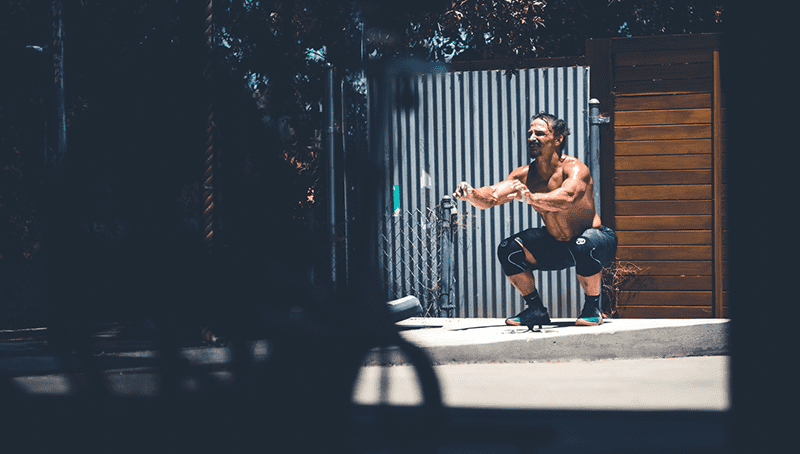 Source: Rehband
Source: RehbandElevated Heart Rate: The explosive jump component of this exercise elevates your heart rate, turning jump squats into a cardiovascular workout as well. This not only helps with overall fat burning but also contributes to improved cardiovascular fitness.
Muscle Building: Jump squats engage both slow-twitch and fast-twitch muscle fibers. This comprehensive muscle activation can help increase lean muscle mass, which in turn boosts your resting metabolic rate, facilitating fat loss.
How to Perform Jump Squats
- Begin in a standing position with your feet shoulder-width apart.
- Lower your body into a squat position by bending your knees and pushing your hips back.
- Keep your back straight and your chest up as you descend into the squat.
- Explosively jump upward from the squat position.
- While in mid-air, extend your body fully.
- Land softly by bending your knees and lowering your body back into the squat position.
- Complete the exercise by immediately transitioning into the next jump squat.
Tips for Effective Jump Squats
Maintain proper form throughout the exercise, keeping your back straight, chest up, and knees tracking in line with your toes.
Land softly to reduce impact on your joints. You can achieve this by bending your knees when you land.
Control your jump and landing to minimize the risk of injury.
Incorporating Jump Squats into Your HIIT Routine
Jump squats can be incorporated into your HIIT workouts in various ways. You can perform them in intervals, combine them with other high-intensity exercises, or use them as a finale to exhaust your lower body and maximize calorie burn.
Jump squats are a dynamic, lower-body-intensive exercise that can help you sculpt your legs, burn calories, and improve your overall fitness.
Whether you’re aiming to reduce belly fat, tone your lower body, or enhance your explosive power, jump squats are an effective choice when included in your workout plan. Consistency is key, so incorporate jump squats into your HIIT routine, and you’ll soon witness the transformation of your lower body and overall fitness.
Plank Jacks: Engaging Your Core
Plank jacks are a challenging and dynamic exercise that combines the benefits of both planks and jumping jacks.
This unique exercise not only engages your core muscles but also raises your heart rate, making it a valuable addition to your High-Intensity Interval Training (HIIT) routine. If you’re seeking to strengthen your core, improve stability, and burn calories, plank jacks are a must-include in your workout plan.
The Science Behind Plank Jacks and Fat Burning
- Plank jacks provide a well-rounded workout that targets both your core and cardiovascular system, making them effective for fat loss and core engagement:
- Core Activation: The plank position in plank jacks forces you to engage your core to maintain stability. This is essential for strengthening your abdominal muscles and supporting a strong, toned midsection.
- Calorie Burn: The dynamic nature of plank jacks requires energy and effort, resulting in a substantial caloric expenditure. This calorie deficit is essential for fat loss.
- Elevated Heart Rate: The jumping motion in plank jacks raises your heart rate, turning this exercise into a cardiovascular workout. This not only contributes to overall fat burning but also enhances your cardiovascular fitness.
- Full-Body Engagement: Plank jacks also engage your upper body, lower body, and hip muscles. This full-body involvement amplifies the calorie burn and helps create a well-rounded workout experience.
How to Perform Plank Jacks
- Start in a high plank position with your hands beneath your shoulders and your body forming a straight line from head to heels.
- Engage your core muscles to keep your body stable.
- While maintaining the plank position, jump both of your feet outward, widening your stance.
- Quickly jump your feet back together to the starting position, mimicking the motion of a jumping jack.
- Continue alternating between the outward and inward motion of your feet.
Tips for Effective Plank Jacks:
- Maintain proper form by keeping your body in a straight line and your core engaged throughout the exercise.
- Focus on a controlled and consistent rhythm to maximize calorie burn and cardiovascular benefits.
- Control your jumps to minimize the risk of injury and reduce impact on your joints.
Incorporating Plank Jacks into Your HIIT Routine:
Plank jacks can be incorporated into your HIIT workouts in various ways. You can perform them in intervals, combine them with other high-intensity exercises, or use them as a core-engaging active rest period between more intense movements.
Plank jacks are a versatile exercise that effectively engages your core while providing a cardiovascular challenge.
Whether you’re aiming to reduce belly fat, strengthen your core, or improve your overall fitness, plank jacks offer a dynamic solution when incorporated into your workout plan. Consistency and proper form are key, so include plank jacks in your HIIT routine, and you’ll soon experience the benefits of a stronger, more stable core.
Sprints are a high-intensity exercise that can deliver remarkable benefits for both your metabolism and calorie-burning potential.
Whether you’re an athlete looking to enhance your performance or someone seeking to lose weight and improve overall fitness, sprints are a fantastic addition to your fitness routine.
The Science Behind Sprints and Fat Burning
Sprints are a potent cardiovascular exercise with a strong emphasis on intensity, and they offer various mechanisms for enhancing fat loss and metabolism:
Caloric Expenditure: Sprints demand a high level of effort in a short duration, resulting in a substantial caloric expenditure. This calorie burn is essential for creating a calorie deficit, which is necessary for fat loss.
 Source: Courtesy of CrossFit Inc.
Source: Courtesy of CrossFit Inc.EPOC Effect: Sprints induce the Excess Post-Exercise Oxygen Consumption (EPOC) effect, which means your body continues to burn calories at an elevated rate even after the workout has ended. This post-exercise calorie burn can last for hours or even days, amplifying the fat loss potential.
Metabolic Boost: Sprinting has been shown to boost metabolism by increasing the production of hormones like growth hormone and adrenaline. These hormonal responses can help your body efficiently burn calories and promote fat loss.
Muscle Preservation: While sprinting primarily targets your cardiovascular system, it also engages your leg muscles. This comprehensive muscle activation can help preserve or build lean muscle mass, which can further enhance your resting metabolic rate and contribute to long-term fat loss.
How to Perform Sprints
- Find a flat, safe, and open area such as a track, field, or even a clear stretch of road.
- Warm up by jogging or performing dynamic stretches to prepare your muscles and joints.
- Choose a starting point and a distance for your sprint. It can be 100 meters, 200 meters, or any distance that suits your fitness level.
- Sprint as fast as you can from the starting point to the designated finish line.
- Slow down to a walk or jog to recover, then repeat the sprint as many times as your fitness level allows.
Tips for Effective Sprints:
- Maintain proper running form, including a slight forward lean, quick turnover of your legs, and powerful arm movement.
- Start with shorter sprints and gradually increase the distance and intensity as your fitness level improves.
- Ensure you have adequate rest between sprints to allow for recovery and maintain your sprinting speed.
Incorporating Sprints into Your HIIT Routine:
Sprints can be a vital component of your High-Intensity Interval Training (HIIT) routine. You can include them as intervals within your HIIT session or dedicate an entire workout to sprinting, with rest intervals in between.
Sprints are a high-impact, high-reward exercise that can significantly enhance your fat-burning potential and metabolism.
Whether your goal is to reduce belly fat, boost your fitness level, or increase your metabolic rate, incorporating sprints into your fitness routine is an excellent choice. With consistency, dedication, and gradual progression, you can tap into the powerful benefits of sprints and watch your fitness goals become attainable.
Kettlebell Swings: Total-Body Power and Fat Loss
Kettlebell swings are a highly effective exercise that not only build total-body power and strength but also contribute to significant fat loss when incorporated into your fitness routine. Whether you’re aiming to enhance your physical performance or shed excess weight, kettlebell swings offer a versatile and dynamic solution.
The Science Behind Kettlebell Swings and Fat Burning
Kettlebell swings are a unique exercise that combines strength, power, and cardiovascular elements, offering various mechanisms to boost fat loss:
Caloric Expenditure: Kettlebell swings are a full-body exercise that requires substantial energy expenditure. The powerful hip thrust and shoulder raise involved in each repetition result in a high caloric burn, creating a calorie deficit necessary for fat loss.
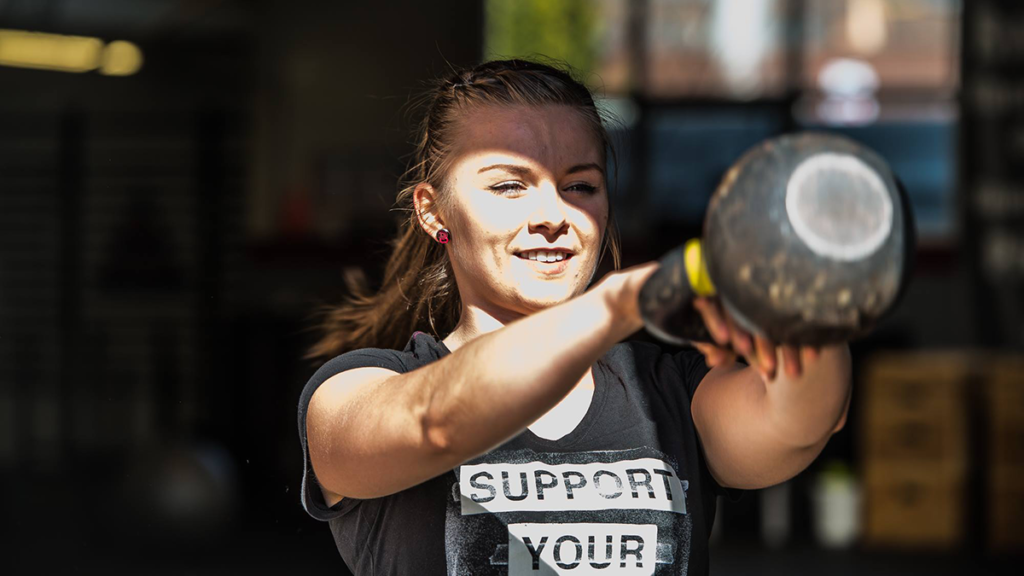 Source: Stevie D Photography
Source: Stevie D PhotographyEPOC Effect: Kettlebell swings, like other high-intensity exercises, induce the Excess Post-Exercise Oxygen Consumption (EPOC) effect. This means your body continues to burn calories at an elevated rate after the workout, potentially for hours or even days, contributing to ongoing fat loss.
Muscle Activation: Kettlebell swings engage numerous muscle groups, including the legs, core, lower back, and shoulders. This comprehensive muscle activation not only enhances strength and power but also supports the preservation and development of lean muscle, further boosting your resting metabolic rate.
Cardiovascular Workout: Kettlebell swings incorporate a dynamic, repetitive motion that quickly elevates your heart rate. This cardio element enhances your cardiovascular fitness and fat-burning potential.
How to Perform Kettlebell Swings
- Stand with your feet shoulder-width apart, toes pointing slightly outward.
- Place a kettlebell on the floor in front of you.
- Bend at your hips and knees to lower your body and grasp the kettlebell handle with both hands.
- Keep your back flat, shoulders down, and your arms extended.
- Swing the kettlebell backward between your legs by pushing your hips back and bending your knees slightly.
- Quickly reverse the motion by forcefully extending your hips and knees, propelling the kettlebell forward and up to shoulder height.
- Let the kettlebell swing back down and repeat the motion for the desired number of repetitions.
Tips for Effective Kettlebell Swings
- Maintain proper form throughout the exercise, keeping your back flat and your core engaged.
- Control the movement and avoid using your arms to lift the kettlebell. The power should come from your hips and legs.
- Start with an appropriate kettlebell weight for your fitness level and gradually increase it as you become more proficient.
Incorporating Kettlebell Swings into Your Routine
Kettlebell swings can be incorporated into your fitness routine in various ways. You can perform them as part of a total-body workout, integrate them into your High-Intensity Interval Training (HIIT) routine, or use them for strength and power training.
Kettlebell swings are a versatile exercise that effectively builds total-body power, enhances cardiovascular fitness, and promotes significant fat loss.
Whether your goal is to reduce belly fat, increase strength, or elevate your metabolic rate, kettlebell swings offer a dynamic solution. By maintaining consistency and progressively challenging yourself, you can harness the full potential of kettlebell swings and work towards achieving your fitness and fat loss goals.
Bicycle Crunches: Targeting Stubborn Belly Fat
Bicycle crunches are a highly effective abdominal exercise designed to target and tone the muscles of your core, making them an invaluable addition to your fitness routine, particularly if you’re looking to trim down stubborn belly fat.
These dynamic and engaging crunches can help you sculpt a firmer midsection while contributing to overall fat loss.
The Science Behind Bicycle Crunches and Fat Burning
Bicycle crunches are a targeted core exercise that can assist in burning fat and sculpting your abdominal muscles:
- Core Engagement: Bicycle crunches engage multiple muscle groups within the core, including the rectus abdominis (the “six-pack” muscles) and the obliques. This muscle activation helps to strengthen and define the abdominal area.
- Caloric Expenditure: While not as intense as some other high-impact exercises, bicycle crunches still require energy and contribute to calorie burn. By consistently incorporating them into your workout routine, you create a calorie deficit necessary for fat loss.
- Muscle Preservation: Engaging your core muscles during bicycle crunches can help preserve existing lean muscle mass, which is crucial for maintaining a higher resting metabolic rate. As you work to reduce fat, maintaining muscle ensures that your body continues to burn calories efficiently.
- Aerobic Element: The continuous and alternating motion of bicycle crunches introduces an aerobic component. While it’s not as intense as cardiovascular exercises, it still elevates your heart rate and contributes to overall fat burning, including stubborn belly fat.
How to Perform Bicycle Crunches
- Lie on your back on an exercise mat with your hands behind your head, elbows pointed outward.
- Lift your legs off the ground and bend your knees, creating a 90-degree angle with your thighs and calves.
- Bring your right elbow toward your left knee while simultaneously straightening your right leg, keeping it off the ground.
- Return to the starting position and switch sides, bringing your left elbow toward your right knee while extending your left leg.
- Continue this pedaling motion, as if riding a bicycle, while simultaneously performing a twisting crunch.
Tips for Effective Bicycle Crunches
- Focus on proper form, ensuring that you’re twisting and crunching from your core rather than pulling on your neck or head with your hands.
- Perform the exercise in a controlled and deliberate manner, emphasizing the quality of the movement over speed.
- Aim for a full range of motion, bringing your elbow as close to your knee as comfortably possible without straining your neck or back.
Incorporating Bicycle Crunches into Your Routine
Bicycle crunches can be incorporated into your fitness routine in various ways. They work well as part of a core-focused workout or can be included in a comprehensive full-body routine. You can also use them as an active rest between more intense exercises.
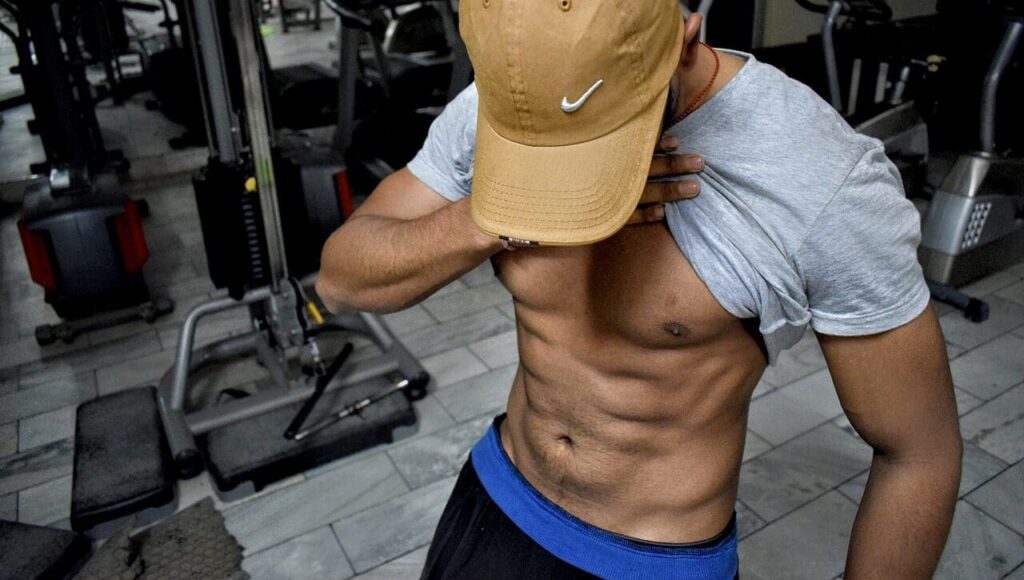
Bicycle crunches are a versatile and effective exercise for targeting and toning the core muscles while contributing to overall fat loss, including stubborn belly fat. Whether your goal is to sculpt a more defined midsection, strengthen your core, or reduce excess fat, including bicycle crunches in your workout routine is a beneficial step. By maintaining consistency and proper form, you can harness the power of bicycle crunches and work toward achieving your fitness and fat loss goals.
Battle Ropes: Fun and Effective Cardio
Battle ropes are a versatile and engaging piece of exercise equipment that not only provide an excellent cardiovascular workout but also add an element of fun to your fitness routine. These thick, heavy ropes are making waves in the fitness world for their effectiveness in torching calories, improving cardiovascular health, and enhancing overall strength and endurance.
The Science Behind Battle Ropes and Fat Burning
- Battle ropes provide a unique workout that combines both strength and cardiovascular elements, contributing to their effectiveness in fat burning:
- Caloric Expenditure: Battle rope workouts are physically demanding, requiring a high level of effort. This effort results in a significant caloric expenditure, creating a calorie deficit necessary for fat loss.
- Metabolic Boost: Battle ropes engage multiple muscle groups, particularly the upper body and core. The comprehensive muscle activation boosts your metabolism and helps you efficiently burn calories, both during and after the workout.
- Cardiovascular Workout: The rhythmic, full-body movements required during battle rope exercises quickly elevate your heart rate. This cardio component contributes to improved cardiovascular fitness and enhances fat-burning potential.
- Interval Training: Battle ropes are often used in High-Intensity Interval Training (HIIT) routines, which are known for their effectiveness in fat loss. The intermittent, high-intensity bursts of effort followed by rest intervals are a proven strategy for shedding excess weight.
How to Perform Battle Rope Exercises
Battle rope exercises come in various forms and can be tailored to your fitness level and goals. Here’s a basic battle rope exercise to get you started:
- Begin by anchoring one end of the battle rope securely to a stable point, such as a pole or a heavy anchor point.
- Stand facing the anchor point with your feet shoulder-width apart and knees slightly bent.
- Hold one end of the rope in each hand, gripping it firmly with your palms facing each other.
- Start moving the ropes in an alternating wave-like motion. Lift one arm and then the other in a continuous pattern, creating a rippling effect along the length of the rope.
- Maintain a consistent and controlled rhythm, keeping your core engaged and your back straight.
Tips for Effective Battle Rope Workouts
- Focus on proper form to minimize the risk of injury. Keep your core engaged and use your hips and legs to generate power in your rope movements.
- Vary the intensity and duration of your battle rope workouts to keep them challenging and prevent plateaus.
- Incorporate battle rope exercises into your overall fitness routine, using them as part of a full-body workout or a dedicated cardiovascular session.
Incorporating Battle Ropes into Your Routine
Battle ropes can be used in a variety of ways. You can include them in a dedicated rope-focused workout or incorporate them into your HIIT sessions. They’re also great for circuit training, combining them with other exercises to create a diverse and effective workout.
Battle ropes offer a fun and dynamic way to improve cardiovascular health, burn calories, and enhance overall fitness. Whether you’re looking to shed belly fat, increase your strength, or elevate your endurance, battle ropes provide a unique and engaging solution. By incorporating battle ropes into your fitness routine and maintaining consistency, you can harness their full potential and work towards achieving your fat loss and fitness goals.
Creating Your HIIT Belly Fat Workout Routine
High-Intensity Interval Training (HIIT) is a highly effective approach to burning belly fat and achieving a leaner, fitter physique. When designed correctly, a HIIT workout routine can help you torch calories, improve cardiovascular fitness, and target stubborn abdominal fat. Here’s how to create a HIIT workout routine focused on shedding those extra pounds around your midsection:
Set Clear Goals
Before you start designing your HIIT workout, establish specific goals. Determine how much weight you want to lose or how many inches you want to trim from your waistline. Having clear objectives will help you tailor your routine to your needs.
 Source: Courtesy of CrossFit Inc.
Source: Courtesy of CrossFit Inc.Choose Effective Exercises
Select HIIT exercises that are known for their fat-burning and core-engaging potential. Include a mix of full-body movements and targeted exercises that engage your abdominal muscles. Some effective choices include burpees, high knees, mountain climbers, jump squats, plank jacks, and bicycle crunches.
Create a Balanced Routine
Structure your HIIT workout to include a variety of exercises that engage different muscle groups. A balanced routine will help you achieve overall fat loss while also targeting your belly fat. For instance, you can start with a full-body exercise like burpees, transition to high knees or jump squats for cardiovascular benefits, and finish with core-specific exercises like plank jacks and bicycle crunches.
Set Intervals
HIIT is all about intervals, which involve alternating periods of high-intensity work with rest or lower-intensity periods. For example, you can perform an exercise at maximum effort for 20-30 seconds, followed by a 10-15 second rest or active recovery period. Repeat this cycle for a set number of rounds.
Customize Work-to-Rest Ratios
The work-to-rest ratios in your HIIT routine can vary depending on your fitness level and goals. A common ratio is 2:1 (e.g., 20 seconds of work, 10 seconds of rest), but you can adjust it to make the workout more challenging or manageable. As you progress, increase the work interval duration and decrease the rest interval for a more intense workout.
Incorporate Proper Warm-Up and Cool-Down
Never skip the warm-up and cool-down phases of your HIIT workout. A good warm-up prepares your body for intense exercise, while a cool-down helps your heart rate gradually return to normal and reduces the risk of post-workout dizziness or muscle soreness.
Plan Your Routine
Lay out your workout routine in advance. Decide which exercises you’ll perform, the order in which you’ll do them, and the number of rounds or sets you’ll complete. Having a clear plan will keep your workout focused and efficient.
Monitor Progress
Keep a record of your workouts to track your progress. Record the exercises, duration, and any changes in performance. Tracking your progress helps you stay motivated and allows you to adjust your routine as needed.
Stay Consistent
Consistency is key to seeing results. Aim to incorporate your HIIT belly fat workout routine into your weekly schedule. Aiming for 3-4 HIIT sessions per week is a good starting point, and you can adjust based on your fitness level and time availability.
Remember that while HIIT is highly effective for burning belly fat, it should be part of a comprehensive approach to weight loss and fitness. Pair your workouts with a balanced diet and lifestyle choices to optimize your results.
HIIT Safety Tips and Common Mistakes to Avoid
High-Intensity Interval Training (HIIT) is a highly effective way to improve fitness and burn fat, but it’s essential to approach it with care and safety in mind. HIIT can be intense, and without proper precautions, you risk injury or overexertion. Here are some HIIT safety tips and common mistakes to avoid:
Safety Tips
Consult with a Healthcare Professional: Before starting a HIIT program, consult with a healthcare professional, especially if you have any underlying health conditions or are new to intense exercise. They can provide guidance on whether HIIT is suitable for you and offer any necessary recommendations.
Warm-Up Adequately: Always begin your HIIT sessions with a proper warm-up. Warm-up exercises prepare your body for the intense work ahead, reduce the risk of injury, and enhance performance.
Maintain Proper Form: Correct form is crucial for injury prevention. Ensure that you execute exercises with proper posture and alignment to minimize the risk of straining or injuring muscles and joints.
Stay Hydrated: Dehydration can hinder your HIIT performance and pose health risks. Drink plenty of water before, during, and after your workout. Replenish electrolytes if you’re sweating heavily.
Listen to Your Body: Pay attention to your body’s signals. If you feel pain, dizziness, or extreme fatigue, it’s crucial to stop and rest. Pushing yourself too hard can lead to injury.
Include a Cool-Down: After each HIIT session, include a cool-down period to gradually lower your heart rate and prevent dizziness. This can also help reduce muscle soreness.
Breathe Properly: Maintain a consistent and rhythmic breathing pattern throughout your workout. Proper oxygen intake is essential for energy and endurance.
Common Mistakes to Avoid
Starting Too Intense: One of the most common mistakes is starting HIIT at an intensity level that’s too high, especially for beginners. Begin at a moderate level and progressively increase the intensity as your fitness improves.
Overtraining: More isn’t always better. Overtraining can lead to exhaustion, injuries, and burnout. Ensure you give your body sufficient time to recover between HIIT sessions.
Neglecting Recovery: Recovery is a vital part of HIIT. It’s during the recovery period that your body adapts and improves. Skipping recovery or active rest periods can hinder your progress.
Ignoring Proper Nutrition: Nutrition plays a crucial role in your HIIT performance and results. Eating a balanced diet with adequate nutrients is essential. Fuel your body with complex carbohydrates, lean protein, and healthy fats.
Lack of Variety: Repeating the same HIIT routine can lead to plateaus and overuse injuries. Incorporate a variety of exercises to challenge different muscle groups and keep your workouts engaging.
Poor Rest and Sleep: A lack of sufficient sleep and rest can impact your performance, hinder recovery, and increase the risk of injury. Aim for 7-9 hours of quality sleep per night.
Comparing Yourself to Others: Everyone’s fitness level is different, and it’s essential to focus on your own progress. Comparing yourself to others can lead to frustration and demotivation.
HIIT can be a highly effective fitness method when done correctly and safely. By following these safety tips and avoiding common mistakes, you can maximize the benefits of HIIT while minimizing the risks of injury and burnout. Always prioritize your well-being and listen to your body during your HIIT workouts.
The Importance of Diet in Your Belly Fat Loss Journey
When it comes to losing belly fat, exercise plays a significant role, but it’s essential to understand that diet is equally, if not more, important.

You’ve likely heard the phrase, “abs are made in the kitchen,” and there’s a great deal of truth to it. Your diet profoundly influences your ability to shed belly fat and reveal a lean, sculpted midsection.
Here’s why diet is crucial in your belly fat loss journey and some dietary guidelines to help you succeed:
Calorie Balance
To lose weight, including belly fat, you need to create a calorie deficit. This means you must burn more calories than you consume. Regardless of how much you exercise, if you’re not managing your calorie intake, it’s challenging to shed fat effectively. A balanced diet that aligns with your daily calorie needs is the foundation of any successful fat loss plan.
Targeted Fat Loss
Unfortunately, you cannot spot-reduce fat from your belly by doing endless crunches or ab exercises. Your body loses fat proportionally, which is why your diet is crucial. By maintaining a calorie deficit, your body will naturally burn fat from all areas, including your midsection.
Nutrient-Rich Foods
Eating nutrient-dense foods provides your body with essential vitamins, minerals, and antioxidants. These nutrients support your metabolism, overall health, and energy levels. A well-rounded diet rich in fruits, vegetables, lean proteins, whole grains, and healthy fats helps you feel satisfied and supports your fitness goals.
Carbohydrates and Fiber
Complex carbohydrates and dietary fiber are crucial for weight loss. They provide sustained energy, stabilize blood sugar levels, and help control appetite. Whole grains, vegetables, and fruits are excellent sources of these nutrients.
Protein
Protein is essential for preserving lean muscle mass while losing fat. It’s also highly satiating, helping you feel full and reducing the likelihood of overeating. Include lean protein sources like chicken, turkey, fish, lean beef, tofu, legumes, and dairy in your diet.
Hydration
Staying well-hydrated is often overlooked but is critical for successful fat loss. Water supports digestion, helps control appetite, and keeps your body functioning optimally. Aim to drink enough water throughout the day.
Avoid Processed Foods
Processed foods, high in refined sugars, trans fats, and excess sodium, can contribute to weight gain, especially around the abdomen. Minimize your intake of sugary beverages, fast food, and processed snacks.
Mindful Eating
Pay attention to portion sizes and practice mindful eating. Eating slowly and savoring your meals can help you recognize when you’re full, preventing overeating.
Consistency
Consistency is key in any dietary approach. Sustainable, long-term changes in your eating habits are more likely to lead to lasting fat loss results.
Seek Professional Guidance
If you’re unsure about creating a balanced diet for your fat loss journey, consider seeking guidance from a registered dietitian or nutritionist. They can tailor a diet plan that meets your specific needs and goals.
In summary, diet plays a fundamental role in your belly fat loss journey. It’s about more than just the number of calories; it’s the quality of those calories and the nutrients they provide. Combine a balanced diet with regular exercise to optimize your fat loss efforts, and remember that patience and consistency are your greatest allies in achieving long-lasting results.
Combining HIIT with Other Workouts for Maximum Results
High-Intensity Interval Training (HIIT) is renowned for its effectiveness in burning fat, improving cardiovascular fitness, and boosting metabolism.
However, HIIT doesn’t have to be a standalone workout. You can maximize your results by integrating HIIT with other fitness routines to create a well-rounded and diverse training program.
Here’s how you can combine HIIT with other workouts for optimal results:
Strength Training
HIIT and strength training complement each other exceptionally well. Strength training builds lean muscle mass, which can increase your basal metabolic rate and help you burn more calories at rest. By incorporating HIIT intervals into your strength training sessions, you can elevate your heart rate, increase calorie burn, and enhance the cardiovascular aspect of your workout.
For example, you can perform a set of strength exercises, like squats, lunges, or deadlifts, and then follow it with a brief HIIT circuit, such as jump squats, burpees, or high knees.
Yoga
Yoga offers numerous benefits, including improved flexibility, balance, and reduced stress. Combining yoga with HIIT can be an excellent way to enhance your overall fitness. You can start your workout with a yoga session to stretch and warm up your muscles, followed by a HIIT routine. After the intense intervals, finish with a cool-down yoga session to help with recovery and relaxation.
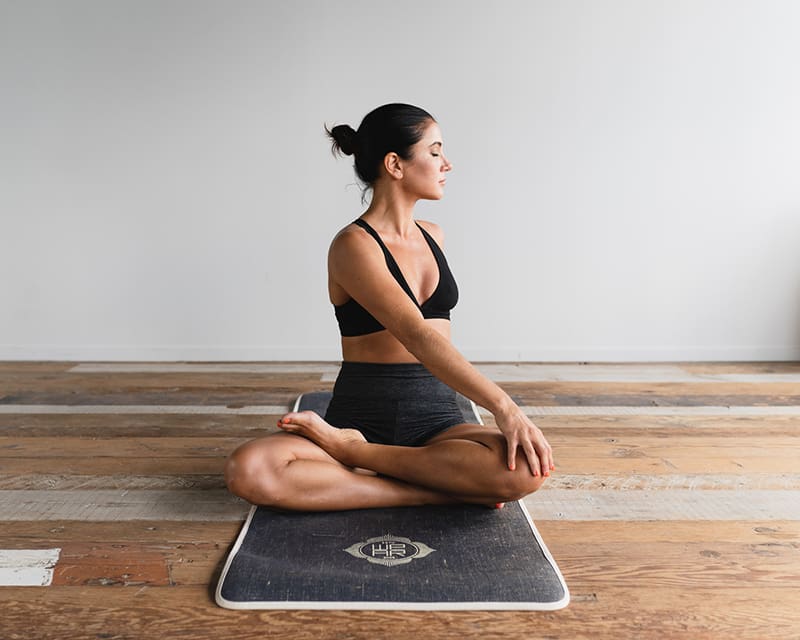 Source: Dane Wetton on Unsplash
Source: Dane Wetton on UnsplashRunning or Cardio Workouts
If you’re a runner or enjoy other cardio activities like cycling, swimming, or dancing, you can incorporate HIIT into your routine to intensify your workouts. For example, during a run, include sprint intervals at maximum effort followed by a recovery jog. This combination can help you boost your endurance and speed while shedding extra calories.
Circuit Training
Circuit training is a combination of strength and cardio exercises performed in a sequence with minimal rest in between. You can incorporate HIIT intervals within your circuit to elevate the intensity of your workout. For instance, a circuit may include bodyweight exercises, dumbbell exercises, and HIIT moves like mountain climbers or plank jacks.
Pilates
Pilates focuses on strengthening the core and improving posture. By adding HIIT to your Pilates routine, you can elevate your heart rate and introduce an additional element of fat burning. Consider incorporating HIIT intervals between sets of Pilates exercises to challenge your body in different ways.
Sport-Specific Training
If you’re engaged in a particular sport or athletic activity, integrating HIIT into your training can help enhance your performance. For instance, swimmers can include high-intensity sprints with rest intervals, basketball players can add agility drills, and martial artists can use HIIT to improve their conditioning.
CrossFit
CrossFit is already a combination of high-intensity workouts and functional movements. However, you can further intensify your CrossFit sessions by adding dedicated HIIT components or finishing your workout with a HIIT circuit.
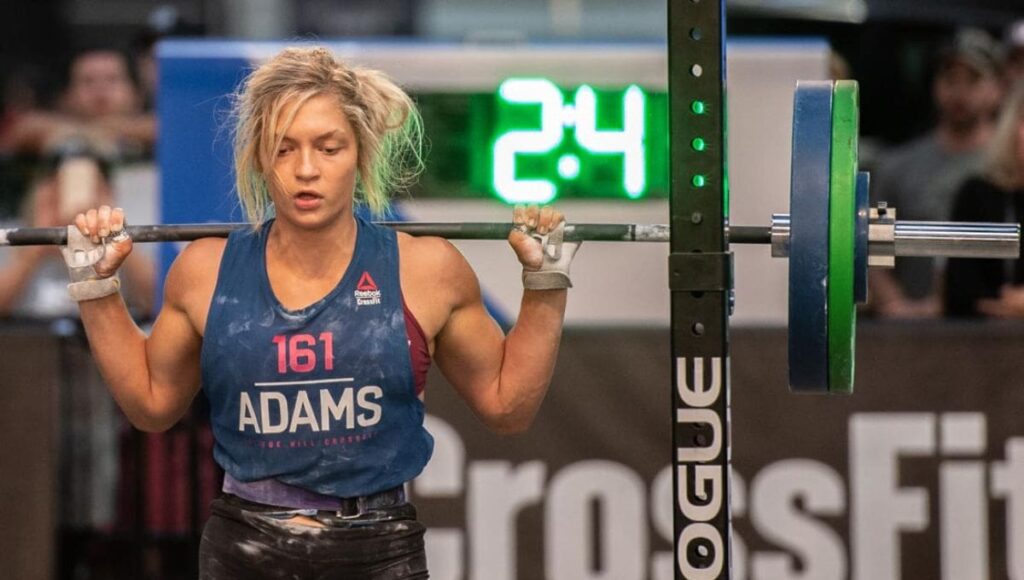
Group Classes
Many group fitness classes, like spinning, aerobics, or circuit training, offer HIIT-style workouts. Participating in these classes can help you diversify your fitness routine and keep things interesting while reaping the benefits of HIIT.
Remember
Pay attention to your body and ensure you allow for adequate recovery between intense workouts.
Consult with a fitness professional to ensure that your combined workouts align with your goals and are safe for your fitness level.
Stay consistent and vary your routines to prevent plateaus and maintain motivation.
By combining HIIT with other workouts, you can enjoy a more balanced, diverse, and effective fitness program. This approach can help you achieve your goals while keeping your workouts engaging and enjoyable.
Tracking Your Progress and Staying Motivated
In your journey to lose belly fat and achieve your fitness goals, tracking your progress and staying motivated are vital aspects of success. Understanding your progress keeps you on the right path and motivates you to continue your efforts. Here are some effective strategies to help you track your progress and maintain your motivation:
Keep a Fitness Journal
Maintaining a fitness journal can be a powerful tool for tracking your progress. Write down details of your workouts, including the exercises, sets, reps, and weights lifted. You can also record your dietary choices, including portion sizes and meal timings. Tracking this data will help you identify trends, patterns, and areas where you can make improvements.
Set SMART Goals
Utilize the SMART (Specific, Measurable, Achievable, Relevant, Time-bound) goal-setting framework. This helps you define clear and attainable objectives, making it easier to track your progress. For example, set a goal to lose a specific amount of belly fat within a certain timeframe or to complete a certain number of HIIT sessions per week.
Use Technology
Leverage fitness apps and devices to monitor your progress. These tools can help you track workouts, measure heart rate, calculate calorie expenditure, and even analyze sleep patterns. Many fitness apps also allow you to set goals, log your meals, and visualize your progress over time.
Take Progress Photos
Capture progress photos at regular intervals, such as once a week or once a month. These photos can provide a visual representation of your transformation and serve as a powerful motivator. Sometimes, the scale may not reflect the changes in your body, but photos can tell a different story.
Keep a Food Diary
In addition to your fitness journal, maintain a food diary to monitor your dietary choices. Document what you eat, when you eat, and portion sizes. This can help you identify areas where you may be consuming excess calories or where you can make healthier choices.
Measure Body Metrics
Regularly measure key body metrics like waist circumference, body fat percentage, and weight. These measurements can reveal changes in your body composition and serve as an objective way to track your progress.
Celebrate Small Wins
Acknowledge and celebrate small victories along the way. Every milestone, no matter how minor it may seem, is a step closer to your ultimate goal. Recognizing your progress, whether it’s an improvement in endurance, strength, or a reduction in belly fat, can provide motivation to keep going.
Share Your Goals
Tell a friend, family member, or workout buddy about your goals. Sharing your intentions with others can create a sense of accountability and support. You’ll be more likely to stay motivated when you have someone who can encourage and check in on your progress.
Join a Fitness Community
Joining a fitness community or online forum can provide you with a sense of camaraderie and support. Engaging with others who have similar goals can help you stay motivated and share experiences, advice, and success stories.
Adjust and Reevaluate
If you hit a plateau or encounter obstacles, don’t get discouraged. Instead, use these challenges as opportunities to adjust your strategy. Reevaluate your goals, training program, and nutrition plan to identify areas for improvement and change.
Focus on Health, Not Just Appearance
While aesthetic goals are common, also emphasize the health benefits of your fitness journey. Improved cardiovascular health, increased energy levels, and reduced stress are all important factors to consider.
Remember that progress in any fitness journey may not always be linear, and there will be ups and downs. The key is to stay committed, patient, and flexible in your approach. By tracking your progress and staying motivated, you can reach your belly fat loss and fitness goals while enjoying a more fulfilling and healthier lifestyle.
Conclusion: HIIT for Lasting Belly Fat Reduction
High-Intensity Interval Training (HIIT) is a potent and versatile tool for achieving lasting belly fat reduction and overall fitness. It offers a combination of cardiovascular benefits, calorie burning, muscle engagement, and time efficiency that makes it a popular choice for those looking to shed excess weight, especially around the midsection.
In this article, we’ve explored the effectiveness of HIIT, delved into the science behind its fat-burning capabilities, and provided an array of exercises to target belly fat. We’ve discussed the importance of a balanced diet, safe practices, and tracking your progress. Now, let’s summarize the key takeaways of incorporating HIIT into your fitness routine for lasting belly fat reduction:
1. Effective Fat Loss: HIIT is a highly efficient approach to losing belly fat due to its ability to create a calorie deficit, elevate metabolism, and induce the Excess Post-Exercise Oxygen Consumption (EPOC) effect.
2. Diverse Exercises: HIIT offers a wide range of exercises, such as burpees, high knees, mountain climbers, jump squats, plank jacks, and more, to keep your workouts engaging and effective.
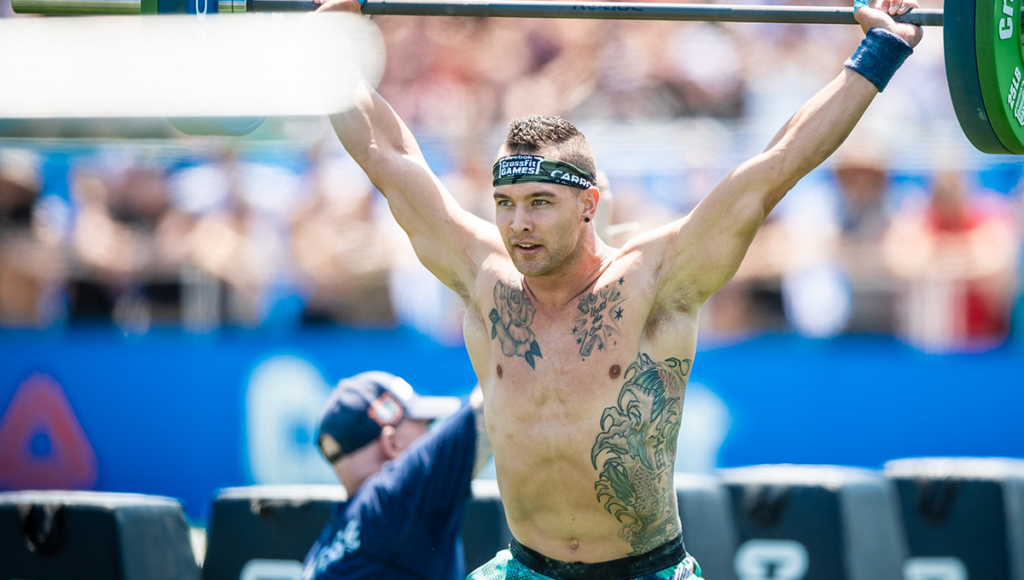 Source: Photo courtesy of CrossFit Inc.
Source: Photo courtesy of CrossFit Inc.3. Comprehensive Benefits: HIIT not only burns fat but also enhances cardiovascular fitness, engages muscles, and contributes to overall well-being.
4. Dietary Considerations: A balanced diet is crucial for supporting your fat loss efforts and achieving a leaner midsection. Pay attention to your calorie intake, food choices, and nutrient-rich options.
5. Safety First: Practice safe exercise techniques, maintain proper form, and listen to your body. Consult with a healthcare professional if you have any underlying health concerns.
6. Track Your Progress: Monitoring your progress through journals, photos, measurements, and technology can help you stay on track and motivated.
7. Combine Workouts: Pairing HIIT with other fitness routines, such as strength training, yoga, or cardio workouts, can provide a well-rounded and diverse approach to fitness.
8. Consistency and Patience: Achieving lasting belly fat reduction takes time, dedication, and patience. Stay consistent in your efforts, be mindful of your progress, and celebrate the small wins along the way.
HIIT is a versatile and effective method for achieving your fitness goals, whether that involves reducing belly fat, increasing strength, or improving cardiovascular health.
By incorporating the principles and strategies discussed in this article into your fitness routine, you can harness the power of HIIT to attain lasting belly fat reduction and enjoy a healthier and more vibrant life. Remember that fitness is a journey, and the destination is a healthier, more confident, and happier you.
Source link: https://www.boxrox.com/9-best-hiit-exercises-to-lose-belly-fat-faster/ by Robbie Wild Hudson at www.boxrox.com






